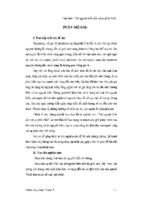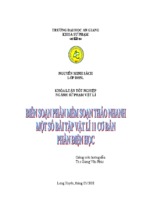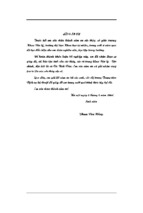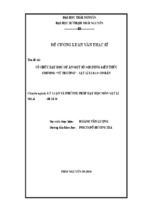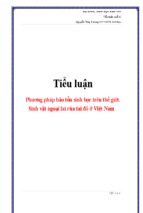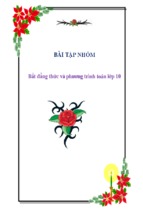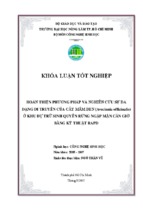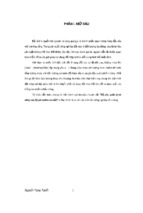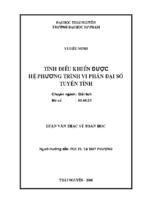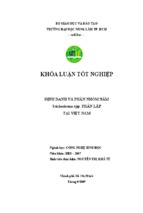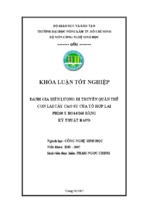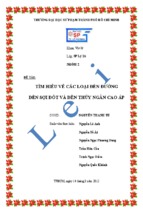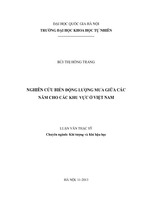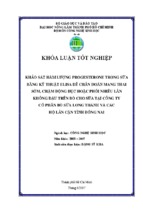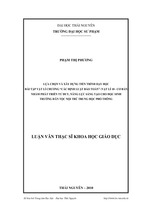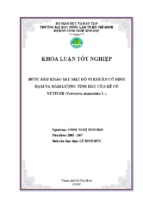RESEARCH PROJECT
(BMBR5103)
RESEARCHING ON THE JOB
SATISFACTION OF LECTURERS AT
HIAST COLLEGE
STUDENT’S FULL NAME
: HUYNH THI MY DIEU
STUDENT ID
: CGSVN00014998
INTAKE
: MARCH 2013
ADVISOR’S NAME & TITLE
: ASSOC. PROF. DR. NGUYEN PHAN
September 2014
i
Advisor’s assessment
.......................................................................................................................................
.......................................................................................................................................
.......................................................................................................................................
.......................................................................................................................................
.......................................................................................................................................
.......................................................................................................................................
.......................................................................................................................................
.......................................................................................................................................
.......................................................................................................................................
.......................................................................................................................................
.......................................................................................................................................
.......................................................................................................................................
.......................................................................................................................................
.......................................................................................................................................
.......................................................................................................................................
.......................................................................................................................................
.......................................................................................................................................
.......................................................................................................................................
.......................................................................................................................................
.......................................................................................................................................
.......................................................................................................................................
Advisor’s signature
ii
Acknowledgements
A completed study would not be done without any assistance. Therefore, the author
who conducted this research gratefully gives acknowledgements to their support and
motivation during the time of doing this research as a requirement of completing my
Master of Business Administration.
First of all, I would like to express my endless thanks and gratefulness to my
supervisor Assoc. Prof. Dr. Nguyen Phan. His kindly support and continuous
advices went through the process of completion of my thesis. Without his
motivation and instructions, the study would have been impossible to be done
effectively.
A part from doing this, I would like to state my thanks to Open University Malaysia
in collaboration with HUTECH University, academic lecturers and staffs
at
HUTECH Institute of International Education, where brings this program to
Vietnam for us be able to joint such a great program.
My special thanks approve to my parents for their endless love, care and have most
assistances and motivation me. I also would like to explain my thanks to my
siblings, brothers and sisters for their support and care me all the time.
As last, my deeply thanks come to all members in Class K08A with their kindly
support during time I joint this program.
With Kindest Regards,
Huynh Thi My Dieu
iii
ABSTRACT
The aim of this study is to identify factors that affecting lecturers’ job satisfaction, and to
evaluate lecturers’ satisfaction. This study will contribute to the confirmation of the scale
factors system that affecting the job satisfaction in general and job satisfaction of lecturers
in particularly. The results of this research will be a valuable source for future related
research on measuring job satisfaction of lecturers. The research model is based on the
theory and results from previous research on satisfaction. A 28-items questionnaire
involving six categories (Nature of Work; Relationship with Colleagues; Salary and
Benefits; Promotion Opportunity and Recognition, Working Condition and Policy and
Management) were used to ensure the reliability and validity. Results show that a majority
of the lecturers are satisfied with their job though not thoroughly. Besides, the research
also shows that there is no difference in the levels of satisfaction among lecturers
according to demographic factors.
Key words: job satisfaction, lecturers
iv
TABLE OF CONTENTS
CHAPTER 1: INTRODUCTION...................................................................................... 1
1.1. Problem Statement .......................................................................................................... 2
1.2. Research Objectives ...................................................................................................... 2
1.3. Research Questions ........................................................................................................ 2
1.4. Scope of Research .......................................................................................................... 3
1.5. Research Methodology ................................................................................................. 3
1.6. Significants of the Research .......................................................................................... 3
1.6.1. Theoretical significances............................................................................................. 3
1.6.2. Practical Significances................................................................................................ 3
CHAPTER 2: LITERATURE REVIEW AND CONCEPTUAL MODEL................... 5
2.1. Theory of jobs satisfaction ............................................................................................. 5
2.1.1. The Concepts............................................................................................................... 5
2.1.2. The need of assessment the job satisfaction ............................................................... 5
2.1.3. The factors affect on job satisfaction of lecturers ........................................................ 7
2.1.3.1. Intrinsic Factors ....................................................................................................... 7
2.1.3.2. Extrinsic Factors ...................................................................................................... 8
2.1.3.3. Demographics Factors ........................................................................................... 10
2.1.4. Measuring job satisfaction:........................................................................................ 11
2.2. Overview the situations of research ............................................................................. 12
2.3. Reasearch Model and Hypothesis ............................................................................... 16
2.3.1. Basement of building research model ...................................................................... 16
2.3.2. Proposal research model ........................................................................................... 21
2.3.3. Hypothesis ................................................................................................................ 22
CHAPTER 3: RESEARCH METHODOLOGY ........................................................... 24
3.1. Research Design .......................................................................................................... 24
3.2. The Scale...................................................................................................................... 26
3.2.1. Salary and benefits scale .......................................................................................... 28
3.2.2. Working conditions scale .......................................................................................... 28
3.2.3. Nature of work scale ................................................................................................ 29
3.2.4. Promotion opportunities and recognition scale ........................................................ 29
3.2.5. Relationship with colleagues scale .......................................................................... 30
3.2.6. Policies and management scale: ................................................................................. 30
3.2.7. General satisfaction scale .......................................................................................... 31
3.3. Data collection ............................................................................................................. 31
3.4. Methods of data analysis process................................................................................. 32
v
3.4.1. Refresh data...............................................................................................................
3.4.2. Reliability and value of scale ....................................................................................
3.4.3. Descriptive Statistics .................................................................................................
3.4.4. Deductive Statistics ...................................................................................................
3.4.4.1. Pearson Correlation Coefficient.............................................................................
3.4.4.2. Variance Analysis (ANOVA) ................................................................................
3.4.4.3. Multivariate regression analysis ............................................................................
32
32
34
34
34
35
36
CHAPTER 4: DATA ANALYSIS ................................................................................... 37
4.1. Analysis of research factors ......................................................................................... 37
4.1.1. Descriptive Statistic based on Age and Gender: ....................................................... 37
4.1.2. Descriptive Statistic based on working experiences.. ............................................... 38
4.1.3. Descriptive Statistic based on Average Income per Month . ..................................... 38
4.1.4. Descriptive Statistic based on Destinations .............................................................. 39
4.2. Factor affecting on job satisfaction of lecturers .......................................................... 39
4.2.1 The scale of salary and benefits: ................................................................................ 39
4.2.2 The scale of working conditions ................................................................................ 40
4.2.3 The scale of nature of work........................................................................................ 41
4.2.4 The scale of promotion and recognition .................................................................... 41
4.2.5 The scale of relationship with the colleagues ............................................................ 42
4.2.6 The scale of policy and management ......................................................................... 42
4.3. Testing scale with Cronbach Alpha reliability coefficient .......................................... 43
4.4. EFA Analysis ................................................................................................................ 48
4.5. Testing the research model .......................................................................................... 49
4.5.1 Analysis Pearson correlation coefficient: .................................................................. 49
4.5.2 Regression analysis ................................................................................................... 49
4.6 ANOVA ANALYSIS ................................................................................................... 57
4.6.1 Job satisfaction between male and female ................................................................. 57
4.6.2 Job satisfaction among ageing group ......................................................................... 57
4.6.3 Job satisfaction by working experiences .................................................................... 58
4.6.4 Job satisfaction by average income ............................................................................ 59
4.6.5 Job satisfaction by destination ................................................................................... 59
CHAPTER 5: CONCLUSIONS AND RECOMMENDATIONS ................................ 62
5.1. Conclusion ...................................................................................................................
5.2. Recommendations ........................................................................................................
5.3. Limitations and suggestions.........................................................................................
5.3.1. Limitations of study: .................................................................................................
5.3.2 Suggestion for further research: .................................................................................
vi
62
64
68
68
68
REFERNCES .................................................................................................................. 70
APPENDIX ...................................................................................................................... 74
List of Figures
[Figure 2-1]: Maslow’s Hierarchy of Needs .......................................................................
[Figure 2-2]: Summary of Herzberg et al.’s two factors theory ........................................
[Figure 2-3]: Proposed research model ...............................................................................
[Figure 3-1]: Research Process ...........................................................................................
17
20
21
25
List of Tables
[Table 3-1]: Salary and benefits scale................................................................................. 28
[Table 3-2]: Working conditions scale ................................................................................ 29
[Table 3-3]: Nature of work scale ...................................................................................... 29
[Table 3-4]: Promotion opportunities and recognition scale ............................................. 30
[Table 3-5]: Relationship with colleagues scale ................................................................ 29
[Table 3-6]: Policies and management scale ...................................................................... 31
[Table 3-7]: General satisfaction scale ............................................................................... 31
[Table 3-8]: Interpret of Correlation Coefficient ................................................................ 34
[Table 4-1]: Age and Gender of respondents...................................................................... 37
[Table 4-2]: Statistics based on working experiences ........................................................ 38
[Table 4-3]: Statistic based on average income per month ................................................. 38
[Table 4-4]: Statistic based on Destination ......................................................................... 39
[Table 4-5]: Results of evaluation on job satisfaction of lecturers based on salary and
benefits. ................................................................................................................................ 39
[Table 4-6]: Results of evaluation on job satisfaction of lecturers based on working
conditions. ........................................................................................................................... 40
[Table 4-7]: Results of evaluation on job satisfaction of lecturers based on the nature of
work. ................................................................................................................................... 41
[Table 4-8]: Results of evaluation on job satisfaction of lecturers based on promotion
opportunity and recognition ................................................................................................ 41
[Table 4-9]: Results of evaluation on job satisfaction of lecturers based on relationship
with the colleagues.............................................................................................................. 42
[Table 4-10]: Results of evaluation on job satisfaction of lecturers based on relationship
with the colleagues.............................................................................................................. 42
[Table 4-11]: Results of reliability test for scale of Salary and Benefits ............................ 43
[Table 4-12]: Results of reliability test for scale of working conditions ............................ 44
[Table 4-13] Results of reliability test for scale of nature of work..................................... 44
[Table 4-14]: Results of reliability test for scale of Promotion Opportunity
and Recognition ................................................................................................................. 44
[Table 4-15]: Results of reliability test for scale of relationship with the colleagues ......... 45
[Table 4-16]: Results of reliability test for scale of policy and management ...................... 45
vii
[Table 4-17]: Results of Cronbach alpha reliability coefficient of the scale ....................... 46
[Table 4-18]: Resullts of KMO and Bartlett's Test from EFA Analysis ............................. 46
[Table 4-19]: EFA Analysis factor ...................................................................................... 48
[Table 4-20]: Model summary ............................................................................................. 51
[Table 4-21]: Pearson analysis’ results of factors affecting lecturers’ satisfaction ............ 52
[Table 4-22]: Pearson Analysis Results on level affecting of factors.................................. 53
[Table 4-23]: Results of coefficients regression analysis ................................................... 54
[Table 4-24]: Results of ANOVA Analysis in comparison level of job satisfaction between
male and female . ................................................................................................................ 57
[Table 4-25]: Results of ANOVA Analysis in comparison level of job satisfaction among
Ageing group ..................................................................................................................... 58
[Table 4-26]: Results of ANOVA Analysis in comparison level of job satisfaction by
Working Experiences ......................................................................................................... 58
[Table 4-27]: Results of ANOVA Analysis in comparison level of job satisfaction by
Monthly Income .................................................................................................................. 59
[Table 4-28]: Results of ANOVA Analysis in comparison level of job satisfaction by
Destination ......................................................................................................................... 60
[Table 4-29]: One-Sample Test ......................................................................................... 61
viii
CHAPTER 1: INTRODUCTION
1.1.
Problem Statement
Teaching staffs are always considered as a core force and the most important factor
in the decision of improving the quality of education. Resolution of the Central
Committee 2 session VIII has identified: “Teacher is the decisive factor for the
quality of education”. The Direction 40-CT/TW of the Party Central Committee's
Secretariat on Building, Improving the Quality of Teachers and Educational
Management also clearly indicated that: “Teachers and educational management are
the core forces and having an important role”. Therefore, to develop education training, the most important is firstly to take care of the construction and
development of teachers.
Generally, the recent changes in the environment of universities in Vietnam has
yielded important results and created major challenges for innovation in operational
management of lecturers. Recently, universities are focusing on the key issue is that
to develop and evaluate lecturers (Tran Xuan Bach, 2006). Researching on job
satisfaction of lecturers is one of the topical issues related to comprehensive
improvement quality of lecturers; the level of job satisfaction of lecturers is up front
factors about attracting and retaining quality lecturers. Therefore, for the
educational institutions, to ensure the quantity, quality lecturers as well as the
effectiveness of training need to understand the factors that influence their job
satisfaction at workplace (Saeed Karimi, 2006; Sharma and Jyoti, 2009).
Ho Chi Minh City Institute of Applied Science and Technology (HIAST) is
assigned to train human sources with synchronization of economic and technical
knowledge to meet the requirements of the nation’s development. Same as other
universities and colleges, HIAST is facing such difficulties in the process of
building the teaching staff with high, ethical and passionate professional
qualifications to meet the need of training. On the other hand, although there is
having the limit of lecturers’ evaluation, but in general, the development of lecturers
1
is somehow remaining issues need to be concerned. The growing demand of
lecturer is an urgent task. Researching on the job satisfaction of lecturers at
HIAST College to find out the strategic solutions, stable and gradual development
of the college in the competitive environment, is considered an essential duty.
1.2.
Research Objectives
This study aims to identify the key factors affecting the job satisfaction of lecturers
in HIAST College and give some solutions to improve job satisfaction of lecturers.
Specifically, this study was conducted to achieve the three objectives in the
following:
-
Identify the key factors affecting job satisfaction of lecturers in HIAST College.
-
Determine the level of job satisfaction of lecturers by elements of influencing
factors.
-
1.3.
Propose some recommendations to improve the job satisfaction of lecturers.
Research Questions:
The study focus on answering the following questions:
-
What are the key factors affecting the job satisfaction of lecturers at HIAST
College?
-
How do lecturers at HIAST College feel satisfied with their job?
-
What are the solutions to improve the job satisfaction of lecturers at HIAST
College?
1.4.
Scope of the Research
The object of research is involved in teaching staff at the college. The study focuses
on aspects of job satisfaction of lecturers. The scope of research includes all
lecturers of Ho Chi Minh City Institute of Applied Science and Technology
(HIAST).
2
1.5.
Research Methodology
Based on the theory of job satisfaction and the results of previous relevant studies to
build the conceptual model (This content will be discussed in details in Part 2:
Literature Review and Conceptual model of research). The study was done by two
steps: preliminary research and formal research. Model of correlation coefficient
alpha of Cronbach (Cronbach's alpha) and the method of EFA (Exploratory Factor
Analysis) are used to evaluate the reliability and validity of the scale, testing model
of the study through Pearson correlation coefficient, ANOVA analysis.
Interpretation of data through a number of tools and descriptive statistics and
statistical inference are done by SPSS software. Data was collected from all
lecturers of the college.
1.6.
Significances of the Research
1.6.1. Theoretical significances
This study will contribute to the confirmation of the scale factors system that
affecting the job satisfaction in general and job satisfaction of lecturers in
particularly. The use of results of foreign research with additional scales adjusted to
suit the training environment in Vietnam is necessary. The results of this research
will be a valuable source for future related research on measuring job satisfaction of
lecturers.
1.6.2. Practical significances
The results of the study will provide to the school leaders recognize the important
factors affecting lecturers’ job satisfaction. Then propose the solutions of
management to improve job satisfaction of lecturers more effectively, thereby
improving the quality of training and education of the college.
Job satisfaction of lecturers at the college will assist the school leaders have the
opportunity to review themselves from the perspective of a customer. This is the
database for the college to identify the strengths and weaknesses, which help to
3
focus on its activities and provide specific and practical policies and programs to
improve satisfaction reasonably.
From the results of construction and measurement scale model as well as factors
affecting job satisfaction of lecturers, higher educational institutions can apply to
measure the job satisfaction of lecturers with same conditions, in order to propose
rational policies in the construction and development of lectures together with
improving quality of its training and education.
4
CHAPTER 2: LITERATURE REVIEW AND CONCEPTUAL MODEL
2.1. Theory of jobs satisfaction
2.1.1. The concepts
There are many definitions of job satisfaction, one of the first and the most cited of
job satisfaction and can include the definition of Hoppock (1935), he said that a
number of psychological factors or physiological environment can also make people
feel satisfied with the work. Vroom (1964) defined job satisfaction is a love of labor
for their current job. According to Webster's Dictionary (1986), job satisfaction is
defined as an emotional state of an individual to be assessed on the job, a positive
response to the work or attitude toward work (led by Mai Ngoc Khuong and Phan
Le Vu, 2014). Locke (1976); Odom, Boxx and Dunn (1990) resulting from Iram &
Ozaira (2013) defined job satisfaction as an extension in which employees feel
positively or negatively about their work. The definition of job satisfaction has risen
in the past decades, but most of studies have noted that a general job satisfaction is
a positive emotional response to the work. However, these studies did not agree on
the cause of creating this feeling. Wezley and Yuel (1984) suggested that this is
influenced by many factors including the nature of individual and job
characteristics.
Obviously, the concept of job satisfaction is very wide. The work of a person does
not simply by transferring the documents, paperwork, waiting customers, or driving.
The work usually requires the interaction with others; compliance with laws,
regulations, and policies of the organization; achieve the performance’s standards;
live in the unexpected environments. This means that the assessment of an
employee in terms of satisfaction or dissatisfaction with their work is a synthesis of
many complex factors of work separately.
2.1.2. The need of assessment the job satisfaction
Job satisfaction is a center point of researchers for decades. There are such reasons
5
why researchers pay attention to this issue.
Firstly, job satisfaction related to the human spirit. The job satisfaction impacts on
issues such as family life, leisure activities, personal issue which does not solve or
solve unreasonable by rational individuals are causing by that person does not find
satisfaction for their work. Many studies have provided evidences to show that job
satisfaction is very important for the psychological life and personal happiness
(Blackbum, Horowitz, Edington, and Klos, 1986 resulted by Saeed Karimi, 2006).
Therefore, measuring of job satisfaction will help identify and improve the negative
relationship between stress with health, morale and satisfaction with life.
Secondly, is to spread goodwill for the organization. According to the view of an
organization, those feel positive about the jobs tend to speak good news about their
organization. They determine the behavior of workers in the organization (M.D.
Pushpakumari, 2008). When a company is praised, the great and dynamic people
want to work for that company. Therefore, the company can attract many talents. It
can be said that job satisfaction be able to make the community have good views for
the organization.
Finally, job satisfaction may help to reduce turnover situation and wasting status. If
we would calculate the damage caused by waste and turnover of staff, then we
could see the importance of job satisfaction. In a society in which people spend
most of the time for work, this is even more important than. Job satisfaction is
essential for employees as well as organizations, the more job satisfaction, the more
efficient with work of particular individuals and companies in general. In fact, jobs
are not simply evaluated by the number of goods being produced, labor productivity
and profit it brings but also by the level of satisfaction that participants get from it.
In the educational sector, measurement of job satisfaction has become a key element
in the study of management and organizational behavior (Spector, 1997, Cranny,
Smith and Stone, 1992, led by Gerard A. Postiglione et. al., 2009). In addition to the
skills and expertise, managers need a better knowledge of understanding the level of
satisfaction of lecturers in various aspects, the difficulties which lecturers are facing
6
and how to increase the level of overall satisfaction with their job (Houchins,
Shippen & Cattret, 2004; Protheroe, Lewis & Paik, 2002; Quaglia & Marion, 1991).
Researching on measurement the job satisfaction of lecturers will help policy
makers and managers at universities or colleges know the current situation of
lecturers, then the job satisfaction will affect to the teaching procedure,
effectiveness of their performances (Spector, 1997; Katzell, Thompson, and Guzzo,
1992; Latham, Mertler, 1998 and 2002), the quality of training at an educational
institution and the most when lecturers dissatisfied with their work will lead to the
results that they will absence from or transfer to other work which raises the cost of
labor and instability of the organization (Steers and Rhodes, 1978; Spector, 1997).
2.1.3. The factors affecting on job satisfaction of lecturers
The topic of job satisfaction and job satisfaction of lecturers has been widely
studied. From theoretical considerations and previous researches on this issue can
be seen that the factors affecting on job satisfaction of lecturers are Intrinsic Factors
(motivating factor), Extrinsic Factors (maintaining factors) and Demographic
Factors.
2.1.3.1. Intrinsic Factors
Lecturers’ satisfaction may be caused by the activities in the classroom, daily
interaction with students, students’ characteristics and control of lecturers in the
classroom (Lee, Dedrick and Smith, 1991), the assign empower for lecturers such as
autonomy and freedom rights to choose textbooks, methods of communication,
curriculum, creativity (Boe and Gilford, 1992) and the opportunities in advanced
promotion are intrinsic factors that affecting lecturers’ satisfaction.
a) The nature of work
The task of lecturers include to prepare lectures, delivery the lesson’s contents,
assessment the learning process of students, classroom management, etc. In
generally, lecturers and workers tend to prefer to work jobs that giving them the
opportunity to use the skills and their capacity and create multi-tasks, freedom and
7
getting the feedback on their job. These features make the job with challenging in
the level of intelligence. The works with less challenging create boring. The
challenge means that it is not too easy but also not too difficult, lecturers can
describe the nature of their work as “routine or change, too easy or too difficult”
(Herzberg et al, 1959), lecturers could give up their work if they would found that
managers prevent their creativity (Maslow and Inman, 1993), a challenging job will
satisfy and please workers.
b) Promotion Opportunity and Recognition
Herzberg et al (1959) defined promotion is changing responsibilities on jobs; in
many cases lecturers easily change the position while still being a lecturer.
Progression creates opportunities for personal growth, more responsibility, and
higher social status. If lecturers are awareness that the promoted decision in the
school is fair then will give them satisfaction.
Recognition, the recognition of well completed job. This can be created from the
individual themselves or from the appreciation of other people, that is attention
activities such as praise or reprimand by superiors, colleagues, managers, clients or
community (Padilla-Velez, 1993 and Bowen, 1980, led by Castillo, J.X. and Cano,
J., 2004). According to Herzberg et al. (1959), the recognition that is the
communication received in writing or orally on the record or praise, this is different
from other rewards by get rewarded in materials. Recognition for lecturers can
come from many different sides as students, parents, colleagues or managers.
c) Relationship with students
The relationship between lecturers with students creates favorable conditions for
students in the process of learning and their progress are one of the important
factors in job satisfaction of lecturers (Scott, Cox and Dinham, 1999). A research by
Friedlander (1978) also showed that the interaction with the students is the main
factor of satisfaction.
8
2.1.3.2. Extrinsic Factors
The various aspects of the extrinsic factors related to job satisfaction of lecturers
include: working conditions, policies and management, supervision, co-workers,
and received valuable materials. If there are poor working conditions, the unsafe
environment and the management is weak, etc. then these characteristics are studied
by many researchers that the lecturers are not met, they will not have motivation,
and if they are not satisfied with the work then they will quit or transfer to another
school (Choy et al., 1993). However, while the internal factors pushing individuals
to become lecturers, these external factors affect their desire to maintain their
career.
a) View and attitude of the leaders
The role of the rector, the school management is a key part of overall job
satisfaction of lecturer (Memon and Christou, 2002). The professional major,
communication skills and social openness of the rector or manager are one of the
external factors, including its fairness, the willingness or unwillingness of leaders in
direct responsibility for the appointment or willing to give instruction for his
colleagues (Castillo and Cano, 2004), provide feedback, encourage lecturers
(Rosenholtz, 1989).
b) Relationship with colleagues
Relationships with colleagues consist of the treatment among individuals with each
other, relationships with leaders and colleagues. The relationship between lecturers
and peers are as one of the external factors, there are many studies of the
relationship between lecturer and colleagues and these are important factors in
overall job satisfaction (Luckner and Hanks, 2003; Bogler, 2001; Ebmeir, 2003,
Popkewitz and Myrdal, 1991).
c) Salary and Benefits
The salary is of each person's income. According to Stanton and Croddley (2000),
satisfaction with salary related to employee perception of fairness in payment.
Teachers entering to the teaching career do not enclose with the dreams of getting
9
rich, but the importance of salary cannot be ignored. Some studies showed the
significant effect of low wages in the educational sector need to be concerned,
related to the reason of quitting job from teachers (Billingshley, 1993; Brownell &
Smith, 1992; Darling & Hammond, 1996).
Benefits are what a person can get from their work except from the salary which he
or she received. The benefits which the employees concerned including social
insurance, health insurance, the statutory vacation, personal and sick leave when
required, retirement benefits, housing, transportation, achievement bonus, overtime
payment, etc. According to Artz (2008) benefits is an important role and have affect
on job satisfaction.
d) Working environments
The working environment has always been of interest to employees because the
working environment related to personal convenience, but it also is a factor to help
them complete the task. Employees do not like the work environment with
dangerous, disadvantage and inconvenience. Temperature, light, noise, and other
environmental factors must be consistent. Moreover, many workers prefer to work
at where closer to home, with clean, modern and appropriate equipment.
e) Policy and Management
Policy and management of an organization means how all activities of an
organization are managed organized? If the organization's policies conflict with the
purpose of either individual or a department, it will bring bad consequences.
Castillo and Cano (2004) explained the components of policy and management in
two-factor theory of Herzberg (1959) is the incident in which some or all aspects of
the organization related to job satisfaction.
2.1.3.3. Demographics Factors
The job satisfaction of employees in general as well as the job satisfaction of
lecturers in particular will be affected by demographic factors such as age,
education, marital status and gender, etc. Many researchers have found the
10
relationships between demographic characteristics with job satisfaction of lecturers
(Smith, 1982; Camp, 1987; Berns, 1990; Stone, 2000; Cano and Miller, 1992;
Clark, Oscwald and Warr, 1996; Haque, 2004; S.Schulze, 2006).
2.1.4. Measuring job satisfaction
Job satisfaction is the general attitude of an individual for their job. This means that
the assessment of an employee on job satisfaction is a synthesis of many complex
factors separately. Researchers in around the world had proposed many valuable
and widely used measurement tools.
The Job Descriptive Index (JDI) was developed by Smith, Kendall and Hulin
(1969), researchers of Cornell University, to assess the level of job satisfaction. The
scale of JDI consists of 90 items was designed to measure the satisfaction of a
person through the nature of work, salary, promotion, co-workers and supervision.
This scale has been used by many researchers extensively over forty years; it has
become one of the most popular tools measuring job satisfaction.
The Job Satisfaction Survey (JSS) was developed by Paul E. Spector (1985) to
assess employee attitudes about every aspects of the job. JSS consists of 36
questions in nine separate aspects of job satisfaction. These aspects include wages,
promotional opportunities, benefits, supervision, organization and management,
relationships with colleagues, nature of work, recognition and responsibility. Every
aspect was assessed with four items, and the total score is calculated from all 36
items. Each item was judged from scale of strongly disagree to strongly agree.
Minnesota Satisfaction Questionnaire (MSQ) was developed by Weiss et al. (1967)
from the University of Minnesota. This questionnaire survey has become a widely
used tool to measure job satisfaction. Three forms of MSQ were developed,
two100-item form (version 1977 and version 1967) and a short form of 20 items.
MSQ questionnaire survey was designed to measure specific aspects of job
satisfaction.
Teacher Job Satisfaction Questionnaire (TJSQ) is defined by Lester (1982) is a
11
dedicated tool to measure job satisfaction of lecturers. TJSQ has linked 66 asking
sections in 9 elements of the job. These factors are defined as supervision, coworkers, working conditions, wages, responsibilities and nature of work, promotion,
safety and recognition. The JTSQ tools presented questionnaires and answer form
of Likert scale with 5 level from 1 is strongly disagree to 5 is strongly agree. The
theory of Maslow (1954) and Herzberg (1959) was the foundation to build and
develop this tool TJSQ. Reliability and validity guarantee and has been used
extensively to measure the job satisfaction of teachers in many educational
institutions in the world.
2.2. Overview the situations of the research
Around the world, there have been many studies mentioned about job satisfaction,
job satisfaction of lecturers in particular. Recently, in Vietnam also have some
studies about the job satisfaction of the employees in many fields and industries
such as healthcare, postal, education, etc.
The research of Luddy Nezaam (2005) was used Job Index Directive (JID) of
Smith, Kendall & Hulin (1969) to study the job satisfaction of workers at the
Institute of Public Health in the Western Cape, South Africa. Luddy surveyed 203
employees about their job satisfaction in five aspects of income, promotion,
supervision, colleagues and the nature of work. Although the results of Luddy’s
study said that all five factors are related to the job satisfaction of employees, but he
said that future research needs to be done in further to confirm this relationship.
Another significant point need to be noted in this study of Luddy is that he
attempted to break the factors affecting job satisfaction in two groups of factors.
The first group is the individual factors including race, gender, education, working
experiences, age and marital status. The second group is called institutional factors
including the nature of work, the compensation/salary, supervision, promotional
opportunities and position.
In the field of education, Saeed Karimi (2005) also studied job satisfaction of 120
12
- Xem thêm -



